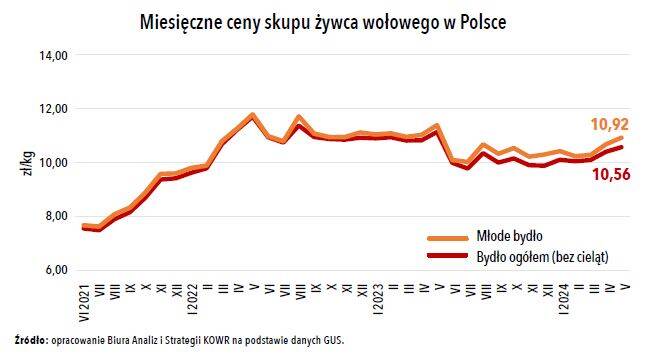Polish beef industry: a growing export market
According to the Polish Statistical Office, Poland's cattle population in December 2023 stood at 6,436,000 head, slightly lower than in December 2022. A decrease in the number of herds was recorded for calves under one year old (-0.5%, to 1,920,000 head) and young cattle aged 1-2 years (-1.9%, to 1,666,000 head). However, the population of cattle aged 2 years and over increased by 1%, reaching 2,850,000 head.
The buoyant foreign demand for Polish beef has led to an increase in the number of cattle delivered to slaughterhouses in Poland since the beginning of 2024. In the period from January to May 2024, industrial slaughter of cattle (excluding calves) amounted to 522,000 tons in live weight (274,000 tons in hot carcass weight) and was 21% higher than in the same period of 2023.

Opening of the Turkish market
In 2024, exports of beef products from the EU to third countries have been increasing, despite limited supplies of beef on the EU market and low price competitiveness of EU beef on the global market. This is the result of, among other things, the opening of the Turkish market to EU beef and a reduction in domestic consumption.
In the period from January to April 2024, EU countries exported a total of 353,000 tons of beef products (in carcass equivalent) to third countries, which is 15% more than a year earlier. The largest amount of beef was sold to the United Kingdom - 118,000 tons, although this was 4% less than in the same period of 2023. A significant recipient of EU beef was Turkey, with an 11% share in export volume.
Low domestic consumption
In Poland, relatively low domestic consumption of beef is one of the factors favoring exports. With annual domestic production of beef at 500-570 thousand tons (in hot carcass weight), about 80-90% of production volume finds buyers abroad. In the period from January to April 2024, Poland exported 179,000 tons of beef and veal products (in carcass equivalent), which is 4% more than a year earlier.


Beef export
Export revenues amounted to 862 million euros (3.7 billion zlotys) and were 3% higher year-on-year. The exported beef assortment was dominated by meat (90% share). 142,000 tons of beef (in product weight) were sold abroad, which is 7% more than a year earlier. The main recipients of meat were EU countries (78% share in volume), including:
- Italy (19%, 27 thousand tons),
- Germany (15%, 21 thousand tons),
- the Netherlands (8%, 11 thousand tons),
- Spain and France (7% each, 10 thousand tons each).
Since the beginning of 2024, exports of Polish beef to non-EU markets have increased significantly (by 66%, to 31 thousand tons), which was contributed to by increased deliveries of beef to Turkey, which in the four months of 2024 were more than four times higher than a year earlier and amounted to 19 thousand tons compared to 5 thousand tons in the period I-IV 2023. Other recipients of beef from Poland were:
- Great Britain (5 thousand tons),
- Israel (3 thousand tons),
- Bosnia and Herzegovina (1 thousand tons), and
- Japan (0.7 thousand tons).
Import
Imports of beef and veal products to Poland were small and consisted mainly of meat (52% share) and live animals (45%). From January to the end of April 2024, 23 thousand tons of beef products (in carcass equivalent) were imported into the country, which is 9% more than a year earlier.
Since the beginning of 2024, the purchase prices of slaughter cattle, both in the EU and in Poland, have shown a moderate upward trend but are at a lower level than a year earlier. At the same time, prices of young cattle of class R3 in Poland, expressed in euros, are on average 3% lower than the average price in the EU, which is a factor favoring the growth of beef exports from Poland.
Source: KOWR